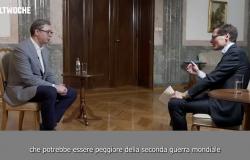Neuralink is ready to insert for the second time his brain implantation in a human being. According to what was reported by Wall Street Journalthe Food and Drug Administration (FDA, the US agency that regulates pharmaceutical and food products) authorized the procedure, approving the measures proposed by the company to resolve a problem that emerged in the chip inserted into its first patient.
The neuroscience society of Elon Musk aims to implant the his device in 10 people this year. Last week the South African entrepreneur said that Neuralink had started collecting applications to select its second patient. Now the Wall Street Journal reports that more than a thousand people with quadriplegia have signed up to the company’s experimental program.
How Neuralink’s first brain chip is doing
The device developed by Neuralink is called Telepathyand it is aneural interface (or BCI, brain-computer interface) composed of a series of semiconductors and advanced electrical components. It can process neural signals and transmit them wirelessly to the application developed by the company, which converts them into actions. The platform records patients’ activity using 1,024 electrodes distributed on 64 ultra-thin and extremely flexible wires.
In late January, the neural interface was implanted in Noland Arbaugh, who, after brief training, was able to use a laptop with thought. But a couple of weeks ago Neuralink engineers reported a problem in the operation of the implant. The company reported that “some wires have detached from the brainresulting in a net decrease in the number of functioning electrodes”.
Neuralink did not provide an official explanation for the mishap, which caused a significant drop in the device’s accuracy and responsiveness. Always according to Wall Street Journalhowever, the startup’s scientists have indicated a possible cause pneumocephalusa condition involving a buildup of air in the skull cavity, usually caused by traumatic injury or surgery (but which poses no serious health risks).
The FDA asked Neuralink to draw up a action plan to avoid similar situations in the future. One of the solutions proposed by the company – and approved by the agency – would be that of increase the depth at which the wires are implanted of the system, going from an interval between 3 and 5 millimeters to 8.
The controversies around Neuralink
Neuralink expects to complete the grafting of its second implant in a human being in June. The technology’s potential has attracted investor interest, leading to a new $43 million venture capital round last November and net funding of $323 million. Despite the hype, the company has been the subject of heavy criticism due to the first tests carried out on the monkeys. Some clinical studies have also called into question the safety of the implants and the ethics of Musk’s company.
Then at the beginning of March Reuters reported that FDA inspectors had detected irregularities in the Californian Neuralink laboratory. The alleged anomalies related to the lack of quality controls and calibration data for some instruments used in animal research. The report came shortly after the company received the necessary permits to begin testing on humans.
The FDA has not released an official statement clarifying the seriousness of the problems encountered. Agency spokeswoman Carly Pflaum explained that the neuroscience company “It has provided sufficient information to support the approval,” adding that the agency routinely conducts inspections to ensure product integrity and reliability and compliance with U.S. regulations. “The FDA will continue to monitor the safety of patients enrolled in Neuralink’s implantable device study“, explained the spokeswoman.
This article previously appeared in Wired en español.






